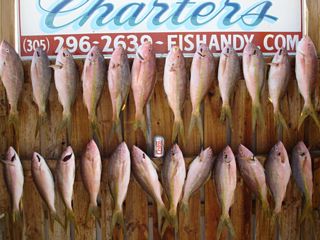 |
 |
Many yellowtail fisherman like to use rolled oats, sand and other additives in addition to the ground chum. Commercial fisherman developed this technique many years ago. The main purpose for using rolled oats is to help cloud up the water (when it is very clear) and ball up the feeding school in a frenzy. To work properly, the rolled oats need to be soaked in water for 2-3 days before use. This mixture of "slop" needs to be distributed at regular intervals and amounts in addition to the chum. Placing and keeping the bait in the cloud created by this mixture, helps to hide the monofilament line. Executed properly, it is one of the ways used to catch large quantities of yellowtail snapper by the commercial vessels. Although yellowtail snappers will eat rolled oats, pure ground up fish chum still works best. For recreational catches of yellowtail snapper, especially in the Dry Tortugas, it is not really necessary to use any type of chum additives.
Yellowtail snapper have exellent vision. Fooling this well developed sense is what makes good yellowtail fisherman. 12-20 lb. test clear monofilament line is best. 10-15' of fluorocarbon leader of the same test will increase your odds, especially if the water is very clear. Attach the fluorocarbon leader directly to the main line using the blood knot or the uni-knot. Do not use any swivels. Absolutely do not use any fluorescent, phosphorescent, or any other high visibility line when fishing any snappers.
Great majority of the people I see on my fishing trips who flat line for yellowtails, hold back or pull back on the line too much. Twitching the rod tip to help the line go off the spool is another big mistake. Instead, gently strip the line off the spool with your free hand. Remember to always keep a slight slack in the line, so it pays out without any resistance. Try to strip the line off of the spool with the same speed as the current. Hold the rod tip steady, pointed in the direction of the drift. On windy days, hold the rod tip very close to the surface of the water. This will prevent the resistance of the wind from blowing your slack line and the bait out of the chum slick. Try to present your bait in the middle of the slick, where the chum concentration is the greatest.
When you get a yellowtail bite, usually, the line will strip off your reel very fast. Immediately close the bail and reel. Do not hesitate, or wait for the fish to "take the bait".
When looking for a spot to anchor for yellowtail snapper, look for any type of reef structure. Coral heads, reef edges, outcrops, or reef patches all attract these snapper. This is where a good depth finder comes in handy. Any suspended marks on the edge of the reef are worth investigating. The marks might not be yellowtail snappers themselves, however, structure that attracts blue runners or baitfish will usually hold good numbers of yellowtails.
Generally, when there is good water visibility, look for these snappers in 60 to 100 feet of water. When the water is cloudy, milky, light green or powder blue in color, you will do better shallower - 40 to 60 feet. Often, when visibility is poor, the fish that will come up to feed in the slick will be quite large. 3-5 pound fish are not uncommon. The school of tails will also hold tighter to the structure when the water visibility is poor. Very slow or no tide is best when fishing low-vis conditions.
It is helpful to chum up the fish initially, even before anchoring, by placing a chum in the bag, and very slowly motoring over the broad area that you plan on fishing. This is especially helpful when fishing a spot that receives little fishing pressure. Anchor just up current of the structure.
Leave the motor running for 10-15 minutes. This will help draw the fish to the boat quicker. Yellowtail snapper are attracted to the sound of the motor (especially diesel). This is because they have been conditioned over the years to associate it with food. Shrimp boats that dump their bycatch every morning, commercial snapper fisherman using mass amounts of chum, and lobster boats hosing off their lobster traps all provide an easy meal for these snapper. One good example of this is the K bouy on the north side of the Dry Tortugas. It is a regular anchoring spot for the shrimp boats that work the area. While commercial fishing for yellowtails snappers in the same area, I have observed the whole school of tails come up in a mad feeding frenzy, when a shrimp boat is passing by. As the boat motors away, the whole school resumes their norman, much slower feeding activity. |